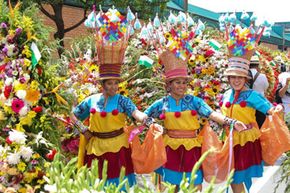Traditional Colombian Festivals
No article on Colombian traditions would be complete without an overview of Colombia's famous carnivals. These colorful celebrations are often multiday events featuring elaborate parades, beauty contests, spirited performances and delicious regional fare. They provide the perfect forum to see, hear and experience the Colombian clothing, music, dance and food we'll be discussing in the rest of this piece. Many travel and tourism sites such as Frommers and ProExport have comprehensive lists of Colombia's major festivals. Here are a few of our favorites:
- Carnaval de Negros y Blancos: Held each January in Pasto, the "Carnival of Blacks and Whites" dates back to ancient Pasto and Quillacinga Indian celebrations held in honor of their moon goddess. Today's event is a celebration of Colombia's multicultural heritage [source: ProExport].
- Carnaval de Barranquilla: Billed as the most colorful carnival in the world, Colombians take to the streets for this annual four-day bacchanal, fusing aboriginal ceremonies with the Afro-Colombian music of Colombia's coastal regions and Catholic festivities brought to the region by Spanish colonists [source: ProExport].
- Ibagué Folk Festival and Bambuco National Folk Festival: These two festivals celebrate the music of Colombia. Ibagué, in the Tolimia region of the Andes, is considered Colombia’s cradle of musical culture. Ibagué’s folk festival, held each June, showcases a variety of Colombian musical styles, including sanjuaneros, bambucos and pasillos [source: ProExport]. The Bambuco National Folk Festival, held in Neiva each June, began as a 10-day rural feast honoring St. John the Baptist. Today, it celebrates Colombia’s bambuco style of music and dance with performances, parades and a beauty pageant [source: ProExport].
- Wind and Kite Festival: Strong winds blow through Villa de Leyva each August. Since 1975, the city has been celebrating with a two-day festival of kites. This Colombian festival is a little off the beaten path and will give you a great excuse to explore Villa de Leyva, a city replete with Spanish colonial architecture and boasting the Plaza Mayor, one of the largest town squares in South America [source: The New York Times].
There are literally dozens of other Colombian festivals, including the Feria de las Flores (The Flower Fair) in Medellin, Carnaval de Bogotá and the Festival Nacional del Joropo. Each has its own local flavor, and you can often spot regional costumes in living color at these festivals.
Advertisement
Speaking of which, let's check out the traditional clothing of Colombia in the next section.
